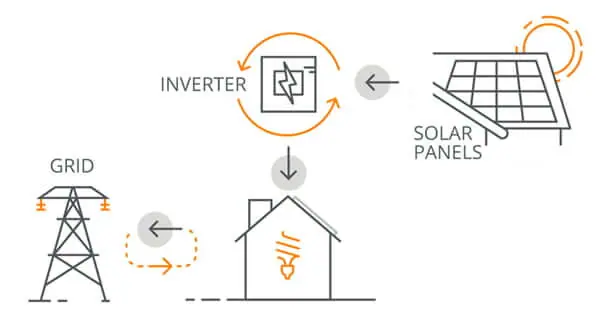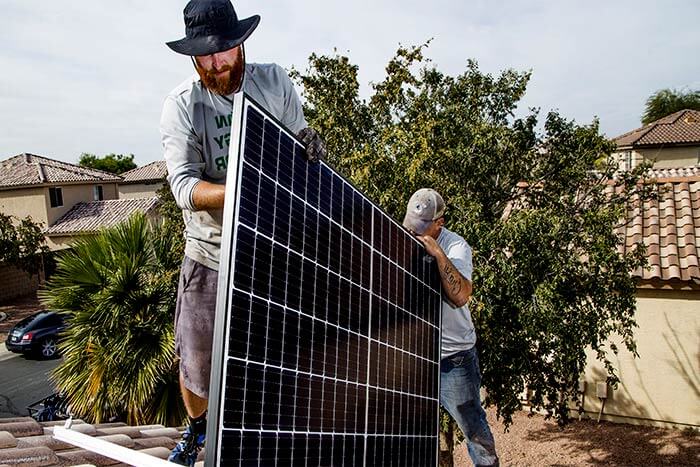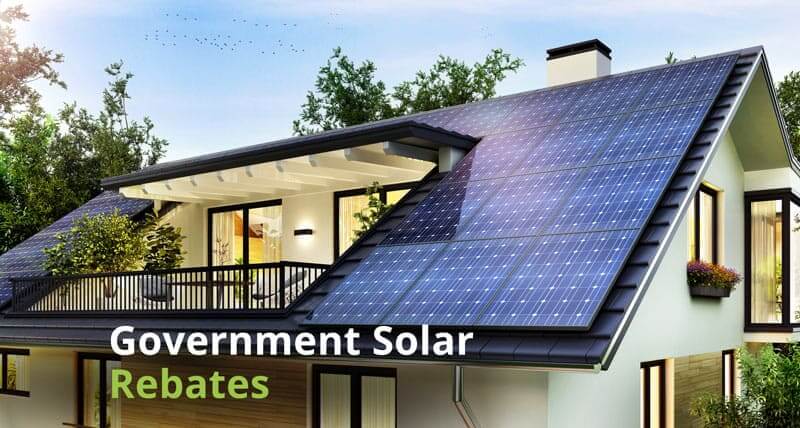Home How Does Solar Power Work?
How Does Solar Power Work?
Solar power transforms sunlight into electrical energy, suitable for application in homes and businesses alike, or can alternatively be fed back into the electrical grid. This operation makes use of solar panels, inverters, and sometimes solar batteries to produce electricity.

Table of Contents
ToggleHow do solar panels generate electricity?
When sun rays strike solar panels, the silicon photovoltaic cells in the panels absorb the rays and convert them into Direct Current (DC).
But since any appliance in your home can’t use the direct current, the electricity is directed to the inverter. Your inverter converts the direct current into Alternating current (AC) the energy you can use in your home or office.
The excess electricity generated can then be sent to the grid or your solar battery for storage.
How does an inverter work?
In any solar system, the inverter works as the brain of operations. You can’t use any power generated by solar panels without incorporating inverter.
As earlier mentioned, the inverters are responsible for converting DC electricity into the usable AC power. They also help with ground fault protection and system analysis by tracking the energy output of your system all times.
There are several types of inverters in the Australian market. The most popular include:
- Central inverters
- String inverters
- Micro inverters
- Hybrid inverters
The central inverter has been the most dominant in the market since a decade. The only issue with this inverter is that a problem in one solar cell (e.g., shading) affects the overall output of the other solar panels.
Most experts are now recommending micro inverters which optimize individual solar panels. This way, any problem with a panel doesn’t affect the output of other panels – allowing them to operate at maximum efficiency.

Does solar power work all the time?
No! Since solar power relies on energy from the sun, power production is limited to the day. At night, you may have to switch back to power from the grid or back-up power from your solar battery.
To compensate for the energy you spend at night, you have the option to join the net-metering program. Under the program, you get credits for the surplus energy you supply to the grid, which goes towards offsetting your power bills.
In shady environments or cloudy days, the solar panels will still generate electricity although their output is reduced to around 15 – 25%.
Do solar panels work in the rain?
Similar to when it’s cloudy, your solar panels may still generate electricity, but the efficiency of the solar panels will be reduced. This is because rain clouds result in minimal sunlight penetration.
The good thing with rain is that it gives your solar panels free cleaning. Remember, dust and debris accumulation on your panel glass can reduce its efficiency by almost 30%.
What time of the day are solar panels most efficient?
While it’s obvious that solar panels work best during sunny days, knowing when the solar panels work best will help you get the most out of your solar system.
Usually, the solar panels generate the most power when the sun is directly above them. This is around noon every day. However, anytime between 10 AM – 2 PM, your solar panels will generate near-maximum energy.
Before 10, energy production is very low, but it increases gradually as the sun’s intensity increases. After 2, the energy production declines significantly as the sun gets lower across the sky.
Keep in mind; these hours are subject to seasonal changes.

Are some times of year better than others?
Yes! The output of your solar panels varies depending on the seasons. During summer, the energy generation is much higher compared to other seasons. This is because the days are longer and the sun is higher in the sky, leading to more sunlight hours.
Therefore, October through to April is the best time to generate solar power.
During winter and parts of Autumn, energy generation is much lower. The days are shorter, and the sun is lower in the sky, meaning fewer sunlight hours.
What is net metering?
Net metering also known as feed-in tariffs, refers to a system that allows solar owners to export their excess unused power back to the grid. In exchange, the solar owners receive some incentives, which help lower the monthly power bill.
In Australia, this scheme is popularly known as the feed-in tariff or the solar buyback scheme.
The amount of incentives you can receive through the feed-in tariff depends on your energy provider and the amount you export to the grid.
Different energy providers will offer you different rates depending on your state. However, you can expect the rate to range anywhere from 7c to 20c per kWh. The feed-in rates will also be higher when you send back power during peak hours.
Here’s a list of companies with the best feed-in rates by state to help you understand better.
| Company | 1st Company (Average Rate) – c/kWh | 2nd Company (Average Rate) – c/kWh | 3rd Company (Average Rate) – c/kWh |
|---|---|---|---|
| NSW | Origin Energy – 16.5 | AGL – 15.55 | Mojo Power – 15.0 |
| VIC | Origin – 17.0 | AGL – 15.65 | DC Power Co – 15.0 |
| QLD | Energy Australia – 16.15 | AGL – 15.3 | DC Power Co – 15.0 |
| SA | AGL – 18.15 | Origin Energy – 16.5 | Power Direct – 16.3 |
| ACT | Origin Energy – 14.0 | Energy local – 12.5 | Energy Australia – 12.5 |
| WA | Horizon – 30.0 | Synergy – 7.2 | N/A |
| NT | Jacana Energy – 23.6 | Power water corporation – 19.23 | N/A |
Is it expensive to install solar panels?
Well, the cost of solar panels will largely depend on the size of the solar system you need and your location in Australia. On average, you can expect to pay around $7,731 (6.6kW) for the installation, but the real range will be between $3,272 – $8,051 for solar panels between 1.5kW to 6kW.
The size of the solar system you’ll need will depend on your home’s energy consumption. Take a look at your monthly bills, the higher it is, the bigger the solar system you’ll need.
There are also several rebates offered in the country and in states which help bring down the cost of solar panels.
Here’s a table showing the average cost of solar by state for solar systems between 1.5kW and 6kW.
| State | 1.5 kW | 2kW | 3kW | 4kW | 5kW | 6kW |
|---|---|---|---|---|---|---|
| New South Wales | $3,357 | $3,785 | $4,453 | $5,368 | $6,284 | $7,387 |
| Victoria | $3,437 | $3,864 | $4,573 | $5,568 | $6,524 | $7,666 |
| South Australia | $3,357 | $3,785 | $4,453 | $5,368 | $6,284 | $7,387 |
| Western Australia | $3,357 | $3,785 | $4,453 | $5,368 | $6,284 | $7,387 |
| Aust. Capital Territory | $3,357 | $3,785 | $4,453 | $5,368 | $6,284 | $7,387 |
| Queensland | $3,277 | $3,665 | $4,254 | $5,169 | $6,005 | $7,028 |
| Avg. of All combined | $3,357 | $3,778 | $4,440 | $5,368 | $6,277 | $7,374 |
Installing solar panels?
Yes, there are! The Australian government runs a solar rebate program under the Small-scale Renewable Energy Scheme. In this initiative, all Australians who install solar systems of up to 100kW are eligible to receive these rebates.
The owners claim the rebates by trading in their Small-scale Technology certificates (STCs) for a point-of-sale discount. Depending on the number of STCs you have, you can receive rebates of up to $3,500 on residential solar and $45,000 on commercial solar systems.
The actual rebate amount you’ll receive will depend on your state. The government subdivided the country into zones according to their sunlight intensities. Zones with higher sunlight intensities receive more STCs.
This rebate program is, however, being phased out slowly. The rebate reduces by 1/15th every year until it finally ends in December 2030.
Some state governments like Victoria, NSW, Queensland, Western and South Australia also run their state rebate programs. Solar owners can also supplement their federal rebates with these to further lower the cost of solar panels.

Will solar power eliminate my electric bills?
Not really. Since your solar panels will only be generating power during the day, you’ll have to rely on power from the grid at night. This will add up to your power cost.
Solar power may eliminate upto 80% of your power bills, leaving you with a small bill at the end of the month.

Is solar power worth it?
Yes! With the price of electricity rising by the day in Australia, investing in solar power could save you more than think. However, it’ll depend on your power consumption habits and goals.
For homes or businesses which consume much, going solar will actually save them thousands annually. Businesses that utilize most of their energy during the day will save even more!
The availability of several incentives and rebate programs for solar panels also drastically reduces their costs. The low prices combined with the enormous savings decline the payback period of the solar panels.
Nevertheless, if you rarely use your power during the day, solar energy may not be the best option.
FAQs
No! When installed by an accredited solar installer, solar panels won’t do any damage to your roof. However, if you use an inexperienced installer, you may end up with holes in your roof, which create water leaks when it’s raining.
Yes, but very little. Solar panels only require light cleaning on the glass surface to remove any dust, leaves, debris or bird droppings that could affect its efficiency. Inviting an inspector once or twice a year to inspect your solar system is also a good practice – it enables you to spot faults before they become disasters.
Table of Contents
Toggle




